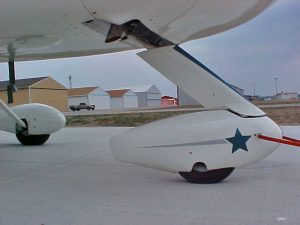Nose wheel shimmy can be a very destructive and difficult-to-diagnose problem in aircraft with free castering nose wheels. Here’s a simple solution to this problem for nose-heavy GlaStars.
Some of you GlaStar builders may have noticed that our 180 hp GlaStar, N918V, had its nose wheel pant removed at Oshkosh last summer. This was because we experienced several instances of nose wheel shimmy on landing, one of which was vigorous enough to fracture the wheel pant.
 The nose wheel shimmy occurrences seemed to be related to the higher weight of the O-360, constant-speed prop installation in N918V. Properly executed, main-gear-first landings prevented the onset of shimmy, but unfortunately, not every demo flight ends with a properly executed landing! We experienced the shimmy at Oshkosh several times on hard, nose-wheel-first landings before the final instance which destroyed the wheel pant.
The nose wheel shimmy occurrences seemed to be related to the higher weight of the O-360, constant-speed prop installation in N918V. Properly executed, main-gear-first landings prevented the onset of shimmy, but unfortunately, not every demo flight ends with a properly executed landing! We experienced the shimmy at Oshkosh several times on hard, nose-wheel-first landings before the final instance which destroyed the wheel pant.
Charley Scott, one of our Glasair builders, sent us some shimmy prevention ideas used on Grumman American aircraft, which have a nose gear system similar to the GlaStar’s. The main recommendation to Grumman owners was to double up on the Belleville spring washers, using two nested pairs of washers instead of two individual washers, and tightening them to the manufacturer’s specifications.
Never above borrowing a good idea, we decided to try this fix on N918V. The specifications from Belleville indicate the optimum effectiveness of the spring washer used in the GlaStar nose gear occurs at 75% crush. This optimum crush percentage can be calculated and easily set on the GlaStar nose wheel by measuring the overall height of a new spring washer, subtracting from this the thickness of the washer material, and multiplying the result by .75. This distance can be accurately applied to the installed washers by measuring the thread pitch of the nose gear fork axle and tightening the nose gear axle nut the correct number of turns to crush the spring washers this distance.
Luckily for us, Cal Spangler did this math and found that turning the axle nut eleven flats past the point of first contact with the washer stack results in just the right amount of crush.
Since this fix was installed on N918V, we haven’t experienced a single instance of nose wheel shimmy. GlaStar builders who have either experienced nose wheel shimmy or anticipate that their aircraft will also have a heavily loaded nose wheel can order two additional spring washers (P/N 085-00103-01) from Option Sales.
(Note to Glasair FT builders and pilots: your airplanes use a slightly different nose gear system incorporating friction pads to prevent shimmy. The technique described above for the GlaStar is not applicable to Glasairs.)



